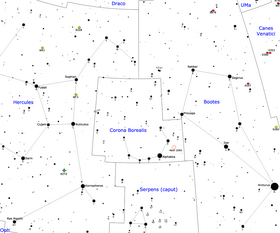Astronomy:Upsilon Coronae Borealis
| Observation data Equinox J2000.0]] (ICRS) | |
|---|---|
| Constellation | Corona Borealis |
| Right ascension | 16h 16m 44.78733s[1] |
| Declination | +29° 09′ 00.9399″[1] |
| Apparent magnitude (V) | 5.78[2] |
| Characteristics | |
| Spectral type | A3V[3] |
| U−B color index | +0.10[2] |
| B−V color index | +0.07[2] |
| Astrometry | |
| Radial velocity (Rv) | 0.8±1.0[4] km/s |
| Proper motion (μ) | RA: +23.474[1] mas/yr Dec.: −16.644[1] mas/yr |
| Parallax (π) | 5.1783 ± 0.0777[1] mas |
| Distance | 630 ± 9 ly (193 ± 3 pc) |
| Absolute magnitude (MV) | −0.72[5] |
| Details | |
| Mass | 3.06±0.19[6] M☉ |
| Radius | 1.5[7] R☉ |
| Luminosity | 151[8] L☉ |
| Temperature | 8,098[8] K |
| Rotational velocity (v sin i) | 112[3] km/s |
| Other designations | |
| Database references | |
| SIMBAD | data |
Upsilon Coronae Borealis, Latinized from υ Coronae Borealis, is a solitary[10] star in the northern constellation of Corona Borealis. It is a white-hued star that is dimly visible to the naked eye with an apparent visual magnitude of 5.78.[2] The distance to this object is approximately 630 light-years (190 parsecs) based on parallax.[1]
This is an A-type main-sequence star with a stellar classification of A3V;[3] a star that is currently fusing its core hydrogen. However, Palmer et al. (1968) had it classed as type A2IV,[11] and thus it may be near or past its main sequence lifetime.[6] It is a suspected variable star of unknown type that has been measured ranging in brightness from magnitude 5.78 down to 5.88.[12]
Upsilon Coronae Borealis has three[6] times the mass of the Sun and about 1.5[7] times the Sun's radius. It is spinning with a projected rotational velocity of 112 km/s.[3] The star is radiating 151[8] times the luminosity of the Sun from its photosphere at an effective temperature of 8,098 K.[8]
References
- ↑ 1.0 1.1 1.2 1.3 1.4 1.5 Brown, A. G. A. (August 2018). "Gaia Data Release 2: Summary of the contents and survey properties". Astronomy & Astrophysics 616: A1. doi:10.1051/0004-6361/201833051. Bibcode: 2018A&A...616A...1G. Gaia DR2 record for this source at VizieR.
- ↑ 2.0 2.1 2.2 2.3 Johnson, H. L. et al. (1966), "UBVRIJKL photometry of the bright stars", Communications of the Lunar and Planetary Laboratory 4 (99): 99, Bibcode: 1966CoLPL...4...99J.
- ↑ 3.0 3.1 3.2 3.3 Royer, F. et al. (February 2007), "Rotational velocities of A-type stars. III. Velocity distributions", Astronomy and Astrophysics 463 (2): 671–682, doi:10.1051/0004-6361:20065224, Bibcode: 2007A&A...463..671R.
- ↑ de Bruijne, J. H. J.; Eilers, A.-C. (October 2012), "Radial velocities for the HIPPARCOS-Gaia Hundred-Thousand-Proper-Motion project", Astronomy & Astrophysics 546: 14, doi:10.1051/0004-6361/201219219, A61, Bibcode: 2012A&A...546A..61D.
- ↑ Anderson, E.; Francis, Ch. (2012), "XHIP: An extended hipparcos compilation", Astronomy Letters 38 (5): 331, doi:10.1134/S1063773712050015, Bibcode: 2012AstL...38..331A.
- ↑ 6.0 6.1 6.2 Zorec, J.; Royer, F. (2012), "Rotational velocities of A-type stars. IV. Evolution of rotational velocities", Astronomy and Astrophysics 537: A120, doi:10.1051/0004-6361/201117691, Bibcode: 2012A&A...537A.120Z.
- ↑ 7.0 7.1 Pasinetti Fracassini, L. E.; Pastori, L.; Covino, S.; Pozzi, A. (February 2001), "Catalogue of Apparent Diameters and Absolute Radii of Stars (CADARS)", Astronomy and Astrophysics 367: 521–524, doi:10.1051/0004-6361:20000451, Bibcode: 2001A&A...367..521P.
- ↑ 8.0 8.1 8.2 8.3 McDonald, I. et al. (2012), "Fundamental Parameters and Infrared Excesses of Hipparcos Stars", Monthly Notices of the Royal Astronomical Society 427 (1): 343–57, doi:10.1111/j.1365-2966.2012.21873.x, Bibcode: 2012MNRAS.427..343M.
- ↑ "ups CrB". SIMBAD. Centre de données astronomiques de Strasbourg. http://simbad.u-strasbg.fr/simbad/sim-basic?Ident=ups+CrB.
- ↑ Eggleton, P. P.; Tokovinin, A. A. (September 2008), "A catalogue of multiplicity among bright stellar systems", Monthly Notices of the Royal Astronomical Society 389 (2): 869–879, doi:10.1111/j.1365-2966.2008.13596.x, Bibcode: 2008MNRAS.389..869E.
- ↑ Palmer, D. R. et al. (1968), "The radial velocities spectral types and projected rotational velocities of 633 bright northern A stars", Royal Observatory Bulletin 135: 385, Bibcode: 1968RGOB..135..385P.
- ↑ Samus', N. N.; Kazarovets, E. V.; Durlevich, O. V.; Kireeva, N. N.; Pastukhova, E. N. (2017), "General catalogue of variable stars: Version GCVS 5.1", Astronomy Reports 61 (1): 80, doi:10.1134/S1063772917010085, Bibcode: 2017ARep...61...80S.
 |


